| Pages:
1
..
3
4
5
6 |
violet sin
International Hazard
    
Posts: 1480
Registered: 2-9-2012
Location: Daydreaming of uraninite...
Member Is Offline
Mood: Good
|
|
This was the kind of thing I was suggesting:
https://www.google.com/patents/US2578674
Nitric oxide recovery system
US 2578674 A
"The optimum temperature has been calculated to be about 60 F.; at this temperature the silica gel adsorbs approximately 6.5% of its weight of
nitrogen dioxide before becoming saturated by a stream of gas containing 1% NO2."
"if one passes 1.19% of NO: through a 3 foot bed of 10-14 mesh silica gel, at 15 C., at the rate of 100 fit/min.. the bed adsorbs with 100% emciency
for 12 minutes. After 12 minutes, the adsorption efficiency begins to fall ofi' and after 31 minutes only 75% of the N02 is adsorbed and 25% is Wasted
to the stack. "
"he nitrogen dioxide may be desorbed from the adsorption gel bed by means of heat introduced into the latter. It is impractical to desorb by heating
the container of the gel bed, because the gel is too poor a conductor of heat. We have discovered that desorption by means of a current of hot gas
consisting essentially of nitrogen dioxide not only is possible but also is much more advantageous than is desorption by steam or by hot air as sole
means."
"have been heated to about 165 C. By means of this treatment the adsorption bed is caused to part from approximately 70% of its adsorbed NO2. If the
adsorbent is heated to a higher temperature level a higher percentage of the NO2 will be released as nearly pure NO2"
You get the idea...
Man some of these patents had horrible translators or numerous deletions-> ". To effect this operation, we heat a supply of NO2, or, a gaseous
mixture consisting largely of NO2, to a temperature of approximately C. " nice to see some of the numbers in things like this just gone... Deff not
the first time I have noticed this in parts of the critical numbers on old patents. Probably crappy document scaning software or under paid staff.
Either way it can be irritating
|
|
|
WGTR
National Hazard
   
Posts: 971
Registered: 29-9-2013
Location: Online
Member Is Offline
Mood: Outline
|
|
That's a good find, violet sin! Reading through this document, I can't help but feel impressed with how clever this whole patent is. The only thing
I think could possibly be suboptimal would be the initial drying by water rinse, since this could produce some acidic waste water. It's not
absolutely necessary anyway. I hadn't really thought of using saturated silica gel as a catalyst for NO oxidation, but it makes perfect sense as to
why this works. In my own experiments, I passed the dry oxidized gas from the oxidation chamber, through the silica gel tube, and into a second
oxidation chamber. I never saw any gas coloration in the second chamber, even after running the reaction for a while. I thought this was odd, as I'd
expect some small amount of unoxidized NO to be getting through the silica gel. I suppose the leftover NO was getting catalytically oxidized in the
silica by excess oxygen.
|
|
|
Chemetix
Hazard to Others
  
Posts: 375
Registered: 23-9-2016
Location: Oztrayleeyah
Member Is Offline
Mood: Wavering between lucidity and madness
|
|
What would happen to the gel-NOx system if it sees ammonia? Can it discriminate? And would absorption be unaffected? I'd think the NO is still
reactive whether or not it's stuck to silica gel. But the idea of using the silica as a oxidation catalyst could help a good deal. There has been left
over NO2 sitting in the oxidation chamber for weeks now, there is acid condensate present and enough air to complete the reactions to nitric I would
have thought, but there it is, a mild reddish colour. The reaction needs very large volumes to complete the reaction and long residence times.
I'm very busy atm with work, can't play with the plant, but have been contemplating the last few runs. One of which was done with (NH4)2SO4 /hydroxide
generator.
The ammonium sulfate system gave good steady flows of ammonia at a full 6-7% of air, I made 20ml of condensate in about 3hrs. But This seems the upper
limit of the catalyst system as it is. There has been ammonia getting through and I've had the silica absorption idea rolling around in my head.
The first modification is going to be catalyst bed geometry, long and skinny= high flow rate low reaction site time, vs. wide and short=large area
slow flow rate high contact time.
It's a balancing act with the dynamic equillibria of all the reactions; NH3 can decompose, so can the NO. I guess the best I can do is make a small
change and see if I can squeeze some more performance out of the system. Without rate studies, engineering is going to be a suck it and see approach.
|
|
|
ecos
Hazard to Others
  
Posts: 464
Registered: 6-3-2014
Member Is Offline
Mood: Learning !
|
|
@Chemetix, any updates? 
|
|
|
Chemetix
Hazard to Others
  
Posts: 375
Registered: 23-9-2016
Location: Oztrayleeyah
Member Is Offline
Mood: Wavering between lucidity and madness
|
|
'Fraid not...busy atm. Want to get to play with the catalyst geometry.
Watch this space as they say.
thnx!
|
|
|
BaFuxa
Hazard to Self
 
Posts: 61
Registered: 18-9-2017
Location: Mars
Member Is Offline
Mood: Buzzing
|
|
Hi everyone,
I have been playing around with the catalytic oxidation of ammonia as well.
I did change a few things to the process that was designed by Chemetix, I used copper (II) oxide and manganese dioxide as the catalyst. If comparisons
are anything to go by, it works just as well as platinum. It does not need constant heating nor insulation, you just heat it up once and it generates
its own heat, as long as the reactants are supplied it keeps going on its own.
As for the products I got either ammonium nitrate or nitric acid straight in the reaction tube ( photo 3 is some copper nitrate that was collected
from it). So it works in fact so well that the NO that is generated upon first oxidation is oxidized a second time and then reacts with the water to
HNO3 which, if ammonia passes unoxidized, makes ammonium nitrate. So I am onto maximizing the surface area in the minimum volume possible.
It is no suprize that industry uses platinum/rhodium gauzes. I need to make a gauze like catalyst bed. Any suggestions on how to do that are welcome.
I tried glass wool as a support but it melts like butter, borosilicate wool partially melts and packs up and ceramic wool tends to glue itself
together as well, but that could be due to catalyst overloading and sintering. Pure quartz wool is about 140$ on ebay so I have to find another way.
As for the ammonia generator I was inspired by the Astral Chemistry process (https://www.youtube.com/watch?v=dMV4-CxCyL0&t=339s) and I put an ammonia solution with a bubbler and a vent port to regulate the gas feed. I
had another pump feeding air as well but its pressure is so high it blocks the ammonia flow and snuffes out the reaction, will have to solve that
problem as well.
I did also try to hook up the urea to ammonia generator to the apparatus but I let go of that idea as I found it just complexified the set up too much
and the gas that is generated does not have a constant rate, you have to monitor it and adjust it to keep things going.
I also tried the electrochemical synthesis of ammonia from urea, it works but you need an electrolytic cell that 1) efficiently keeps the cathodic and
anodic gases separated as this process generates N2 NH3 and H2, which is not desirable since it will favor a recomposition to NH3 and 2 ) should also
be fairly large. I find it easier to make an ammonia solution from urea first but I keep an eye on these methods.
Anyway, long write up but I have been on this on and off from some months now and I thought I should give you guys a progress report of some sort.
Thanks for reading.
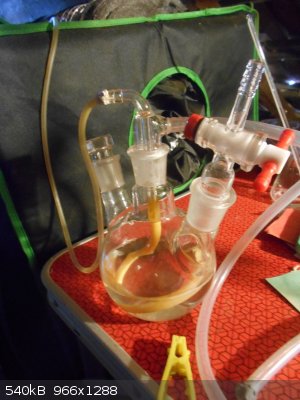 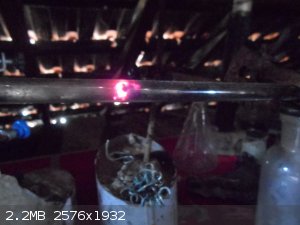 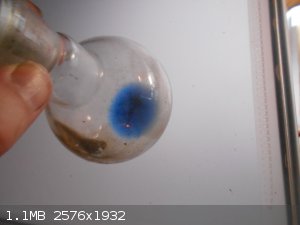
[Edited on 8-7-2018 by BaFuxa]
[Edited on 8-7-2018 by BaFuxa]
[Edited on 8-7-2018 by BaFuxa]
Potential counts for nothing until realized.
|
|
|
Chemetix
Hazard to Others
  
Posts: 375
Registered: 23-9-2016
Location: Oztrayleeyah
Member Is Offline
Mood: Wavering between lucidity and madness
|
|
Great set up! Congratulations on getting it working! The catalyst temps are a bit of a challenge. The crushed tile or bricks seemed to have a good
surface area with porosity and allow the catalyst to soak into and onto the surface. They took the temperature well. You have noticed that ammonium
nitrate forms when there is too much ammonia to air, I found 6% or thereabouts seems to work best with my cobalt catalyst at not producing ammonia.
Playing with the geometry of the catalyst bed was going to be my next area of inquiry, wide and short or skinny and longer, to play with residence
times and balancing the heat of reaction with subsequent reaction NO -> N2+ O2 that occurs when the nitrogen oxide is still in contact with the
catalyst.
But controlled release of ammonia is probably the most valuable technological innovation at this stage.
Best wishes and keep us posted
|
|
|
XeonTheMGPony
International Hazard
    
Posts: 1640
Registered: 5-1-2016
Member Is Offline
Mood: No Mood
|
|
I started to make a reactore tube, will be a while yet but look forward to it. BTY Any reason no one has don a small scale haberbosh plant?
|
|
|
Texium
Administrator
       
Posts: 4580
Registered: 11-1-2014
Location: Salt Lake City
Member Is Online
Mood: PhD candidate!
|
|
Wow. How did I manage to never see this thread before? Unbelievable!
It shall be stickied posthaste!
|
|
|
Texium
|
Thread Topped
8-7-2018 at 18:30 |
Herr Haber
International Hazard
    
Posts: 1236
Registered: 29-1-2016
Member Is Offline
Mood: No Mood
|
|
Quote: Originally posted by XeonTheMGPony  | | I started to make a reactore tube, will be a while yet but look forward to it. BTY Any reason no one has don a small scale haberbosh plant?
|
Because the fablab / hackerspace is more than 30km from home !!! 
Otherwise, that would be my number 1 goal given a place and the resources of a fully equipped workshop.
|
|
|
VSEPR_VOID
National Hazard
   
Posts: 719
Registered: 1-9-2017
Member Is Offline
Mood: Fullerenes
|
|
What keeps the nitric acid from reacting with the copper oxide catalyst?
Within cells interlinked
Within cells interlinked
Within cells interlinked
|
|
|
Ubya
International Hazard
    
Posts: 1247
Registered: 23-11-2017
Location: Rome-Italy
Member Is Offline
Mood: I'm a maddo scientisto!!!
|
|
the catalyst should only be in contact with ammonia, air, and their products, nitrogen monoxide and dioxide (and or dinitrogen tetroxide), nitric acid
is formed later in the absorbtion tower, so if there is a positive pressure (as it should be) no nitric acid will ever be in contact with the catalyst
---------------------------------------------------------------------
feel free to correct my grammar, or any mistakes i make
---------------------------------------------------------------------
|
|
|
BaFuxa
Hazard to Self
 
Posts: 61
Registered: 18-9-2017
Location: Mars
Member Is Offline
Mood: Buzzing
|
|
Success
Quick update, I have made HNO3 from my set up. Same catalyst was used except it was unsupported and required external heating ( wanted to try
unsupported just to see), I made sure the air : ammonia ratio was correct by going over the tube fittings. This is the most important thing here with
the catalyst, the (molar ) ratio of NH3 to O2 should be 4 : 5, less than that and you are making either N2O or N2. You check this by eye, if you see
NO2 gas you are doing it right. It is a matter of knobs adjustment. No sintering of the catalyst was observed.
Oxidation tower was made with a gas washing bottle with an air inlet.
After about 3 minutes of running time I had some HNO3 in the receiving flask. Strong smell of nitric acid, PH 2.13. My dependency on ( very costly)
nitrate salts is now over  . Now next challenge is to make 99% HNO3 from this mu
ha ha ha. . Now next challenge is to make 99% HNO3 from this mu
ha ha ha.
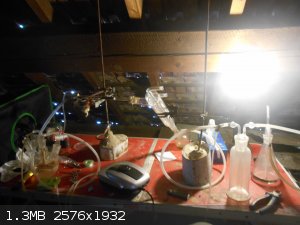 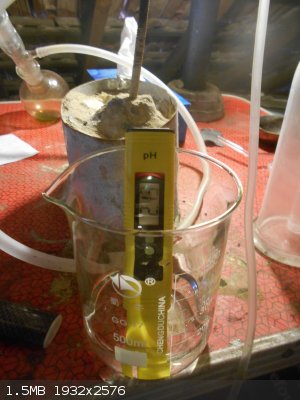 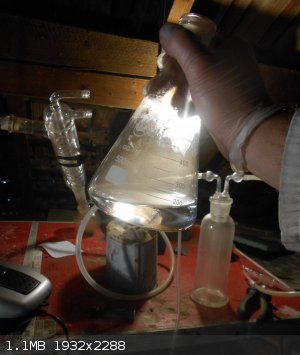
[Edited on 5-8-2018 by BaFuxa]
Potential counts for nothing until realized.
|
|
|
j_sum1
Administrator
       
Posts: 6320
Registered: 4-10-2014
Location: At home
Member Is Offline
Mood: Most of the ducks are in a row
|
|
Woohoo!
Congratulations. Nicely done.
Now I need to go back over this thread carefully to see how it was done. Getting HNO3 from easy-to-get reagents is quite an accomplishment.
|
|
|
Deathunter88
National Hazard
   
Posts: 519
Registered: 20-2-2015
Location: Beijing, China
Member Is Offline
Mood: No Mood
|
|
Congrats! But I have to ask, are you able to produce a feasible amount of acid with this method? A pH of 2.13 indicates very little actual nitric
acid. (A few drops of nitric acid in 500ml of water is easily able to bring the pH to 1 or lower.) It seems to me at this point this is more of a
proof of concept than a feasible route to usable quantities of nitric acid. Feel free to prove me wrong though, that would be even better.
|
|
|
WGTR
National Hazard
   
Posts: 971
Registered: 29-9-2013
Location: Online
Member Is Offline
Mood: Outline
|
|
Quote: Originally posted by BaFuxa  | It is no suprize that industry uses platinum/rhodium gauzes. I need to make a gauze like catalyst bed. Any suggestions on how to do that are welcome.
I tried glass wool as a support but it melts like butter, borosilicate wool partially melts and packs up and ceramic wool tends to glue itself
together as well, but that could be due to catalyst overloading and sintering. Pure quartz wool is about 140$ on ebay so I have to find another way.
|
I'm planning to get some of this 1mm silica wick from eBay:
https://www.ebay.com/itm/3mm-High-Quality-Silica-Rope-Wick-T...
It looks like it has multiple strands in the cord, so it may be possible to make the thread even thinner than 1mm.
One option would be to try weaving a small piece of mesh from the material, and then impregnating the mesh with the catalyst. Another option would be
to calcine the catalyst into beads around the silica thread, making a string of beads on the thread.
http://www.sciencemadness.org/talk/viewthread.php?tid=55&...
|
|
|
BaFuxa
Hazard to Self
 
Posts: 61
Registered: 18-9-2017
Location: Mars
Member Is Offline
Mood: Buzzing
|
|
Quote: Originally posted by Deathunter88  | | Congrats! But I have to ask, are you able to produce a feasible amount of acid with this method? A pH of 2.13 indicates very little actual nitric
acid. (A few drops of nitric acid in 500ml of water is easily able to bring the pH to 1 or lower.) It seems to me at this point this is more of a
proof of concept than a feasible route to usable quantities of nitric acid. Feel free to prove me wrong though, that would be even better.
|
Indeed I just wanted to see if it worked but there is no reason this should not produce very large amounts at very high concentrations. One step at a
time.
Potential counts for nothing until realized.
|
|
|
WGTR
National Hazard
   
Posts: 971
Registered: 29-9-2013
Location: Online
Member Is Offline
Mood: Outline
|
|
At least you're getting more acid than unconverted ammonia. That is an accomplishment. Are you able to test the product for ammonia to see how much
got through? If yield is ever low because the ammonia is getting over oxidized to nitrogen, this is less of a problem I think, than if unconverted
ammonia is getting past the catalyst. In any case, welcome to the brown gas club!
|
|
|
Alkoholvergiftung
Hazard to Others
  
Posts: 177
Registered: 12-7-2018
Member Is Offline
|
|
If you Need an carrier material you could use Zeolithe Stones. You could excange the sodium inons with your catalaytic heavy metal Ions. Than you
have an Catalyst with an very big survace erea. I recommend Ammoniumdichromate solution. Let it few days dry heat it and Ready to go.
|
|
|
Chemetix
Hazard to Others
  
Posts: 375
Registered: 23-9-2016
Location: Oztrayleeyah
Member Is Offline
Mood: Wavering between lucidity and madness
|
|
Furnace development
My long absence is not an indication that I've abandoned the project, still thinking of some better ways to do things. A recent experiment has made
the need for quartz reaction tubes a little redundant.
I was given a tube of what I think is an alumino silicate refractory which is used as a kiln element support so they are going to be structurally
sound above 1200C. They should be chemically inert to steam at these temperatures; even quartz fails this test. This should be a fantastic material
for a tube furnace. But connecting it to labware is a bit of a pain.
Would it join to borosilicate? If it did then putting joints on it would be very convenient for all sorts of furnace work. The result is- Yes it can
be joined to borosilicate!
If anyone would like to try one with joints I can do them very economically . HMU if you have an experiment that can use 20mm dia tubing.
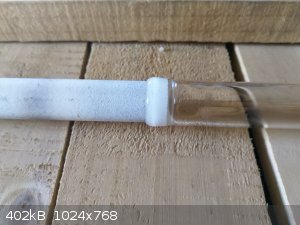
|
|
|
j_sum1
Administrator
       
Posts: 6320
Registered: 4-10-2014
Location: At home
Member Is Offline
Mood: Most of the ducks are in a row
|
|
Chemetix, that looks like a wonderful innovation you have there. Could be useful for CaC2 and CS2 synthesis amongst other things.
I want one. Sending you a U2U.
|
|
|
WGTR
National Hazard
   
Posts: 971
Registered: 29-9-2013
Location: Online
Member Is Offline
Mood: Outline
|
|
Quote: Originally posted by Chemetix  |
Would it join to borosilicate? If it did then putting joints on it would be very convenient for all sorts of furnace work. The result is- Yes it can
be joined to borosilicate!
If anyone would like to try one with joints I can do them very economically . HMU if you have an experiment that can use 20mm dia tubing.
|
That’s interesting. Do the materials have the same expansion coefficients? It would be interesting to know what the material is. I’m assuming
you fused them together with a torch.
|
|
|
Chemetix
Hazard to Others
  
Posts: 375
Registered: 23-9-2016
Location: Oztrayleeyah
Member Is Offline
Mood: Wavering between lucidity and madness
|
|
[/rquote]
That’s interesting. Do the materials have the same expansion coefficients? It would be interesting to know what the material is. I’m assuming
you fused them together with a torch.[/rquote]
Borosilicate can be joined to similar coefficients of thermal expansion, with the right technique it can be quite forgiving sometimes. It was one of
those suck it and see moments. Fortune favours the brave. I'll try to find out what the material is exactly.
And the join was done on my glass lathe with a torch, I don't think it would be very easy to do by hand.
|
|
|
geffmov
Harmless

Posts: 5
Registered: 22-1-2019
Member Is Offline
|
|
Hi, i like what youre doing.
Have you considered a tilly lamp mantle to support catalyst?
Its designed specifically to do what youre after doing, and youll have minimum residence time. Importantly each replacement will be same as the last,
giving you more consistancy.
Also if you look carefully different types of mantles are already impregnated with various rare metal oxides. Barium, cerium etc. Some may be no
good, some i feel will work very well.
you can spread the mantles for maximum gas exchange and complete oxidation by clamping over a feeder pipe
I think from my own experience of metal catalysts in other areas youll find they vary in activation temperature dramatically, and selectiveness. Some
are too harsh.
some can be regenerated in a hydrogen atmosphere heated for an hour or two.
Id feel platinum would give you most stable results. It was the original catalyst on tilly mantles too.
thanks for the informative thread
Edit- i did some researching myself. chapter 10 - 744page, Industrial chemistry book.. 'Oxidation of Ammonia' is a great read.
Platinums favoured because of its selectivity over a wider range of temperatures. It appears a simple platinum gauze 80mesh 1foot diameter is used
in the industrial preparation. Temperatures are kept on the low side of the 1924 patent so catalyst lasts longer.
800-900c tops although upto 1300c will give the desired result nitrogen formation from competing side reactions come more noticable as temperature is
raised.
They suggest 11parts ammonia 89parts air is optimal
It appears they preheat the gases too 700c then the exothermic reaction on the gauze itself to 800-850c
will give a 90% yield
Ammonia can form an explosive mix over 16%
Your flowrate over the gauze will be dictated by its temperature.
If youre looking for an alternative catalyst ive a suggestion over a recent innovation, thats copper been treated with argon. Apparently the copper
behaves like a noble metal. It may not be possible to do this in a clandestine laboratory. I dont have references to hand sorry.
I also like the idea of the heating element sleeve been impregnated with catalyst.
The tilly mantle i suggested would be ideal but its drawback is once set and burned in, its brittle
[Edited on 23-1-2019 by geffmov]
|
|
|
BaFuxa
Hazard to Self
 
Posts: 61
Registered: 18-9-2017
Location: Mars
Member Is Offline
Mood: Buzzing
|
|
Did not know about tilly lamp mantles. Interesting but the fixed bed design did word well enough.
I have left the HNO3 for now, other projects at hand. I may revisit this synthesis if time allows. You are free to pick it up.
Potential counts for nothing until realized.
|
|
|
| Pages:
1
..
3
4
5
6 |